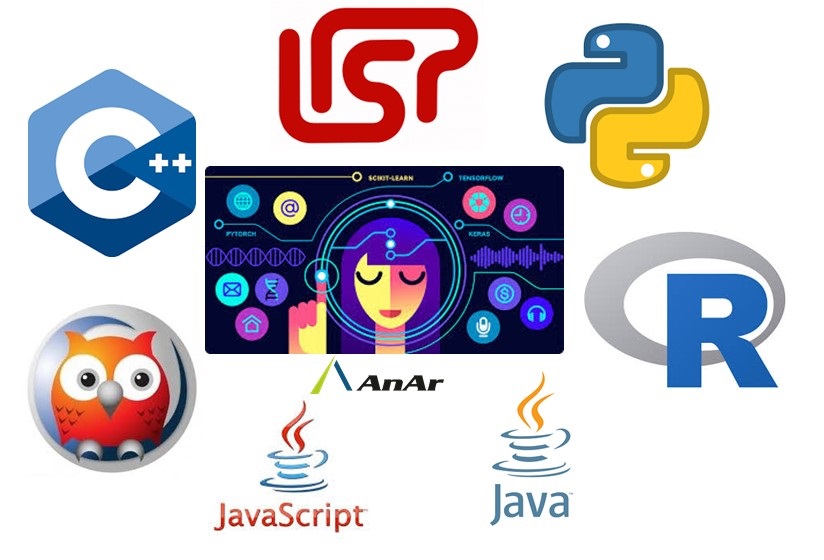Artificial Intelligence proposes human-made abilities to think and understand. We can train computers to perform tasks that currently humans surpass the machines. Machine Learning is a self-learning technique developed using AI gathered data. ML can support the study of data and creating self-learning algorithms increasing the knowledge quotient. AI leads to intelligence required to solve complex problems and aid decision making.
Coding Practices includes a selection of appropriate programming languages for AI & Ml app designing. Intrinsically the benefits of each language straight away affect the efforts of coding for a unique solution.

Top 5 Programming Languages for AI:
- Python
- R
- Lisp
- Prolog
- Java
Top 5 Programming Languages for ML:
- Python
- C++
- Java
- JavaScript
- R
Virtues of Programming Languages for better Coding Practices:
- Python: Simple syntaxes and easy to learn, and has plenty of libraries and tools that can ease out AI & ML work.
- R: Detailed mathematical or statistical manipulation makes it an effective language for ML. This language supports ML development libraries and tools; data scientists prefer it.
- Lisp: It is one of the old and reliable languages for AI development. Many of the features no more remain available exclusively for Lisp.
- Prolog: The powerful features like tree-based data structuring, pattern matching, and backtracking make it an effective programming framework for AI.
- Java: It is the best choice for large projects wherein a lot of search algorithms and graphical representation of data is required.
- JavaScript: A web scripting language has many ML libraries, tools, and frameworks; preferred for ML.
- C++: Its speed, rich library, and memory management abilities make it popular structured programming language preferred in ML platforms.
Best Artificial Intelligence and Machine Learning Frameworks and Libraries:
Tools and libraries help developers to build AI & ML projects at a high pace and effortlessly. It empowers developers to deal with clustering, regression, and classification, which are the most common problems in AI programming.
- TensorFlow: This open-source AI development tool is perfectly suitable for a less experienced Artificial Intelligence Programmer.
- Torch/ Pytorch: AI system created by FB has adequate documentation that helps in programming especially when an entire range of algorithms and multiple indexing is used.
- Caffe: It is one of the most popular ML frameworks among new data scientists. It lets you build apps that need image classification.
- Theano: Mainly used for projects that involves multidimensional arrays, mathematical expressions and its evaluation.
- Amazon Machine Learning: It provides ready to use solutions for AI frameworks.
- Accord.NET: This language is in use for audio and image processing and tackles AI problems like Clustering and Distribution.
- Scikit-learn: It has a consistent Python interface that provides learning algorithms. Its ML library lets you deal with major AI problems.
- Microsoft CNTK / Microsoft Cognitive Toolkit: An open-source toolkit helps beginners in creating a variety of AI applications. It also supports C++ API.
- Keras: This Python framework can be of great help when working with other frameworks simultaneously.
- MXNET: This open-source framework supports multi-GPU and multi-machine training.
- Auto ML: The most suitable tool for newcomers in the fields of machine learning and easily build new software.
- Azure ML Studio: Data professionals can create large Machine Learning models in the cloud using this tool with its wide range of algorithms and modeling options.
Types of Complexities in Programming for Artificial Intelligence and Machine Learning apps:
- Creating simple applications face the challenges of selecting an accurate methodology of performing things. This is due to the availability of too many ways to program ML applications.
- Converting a thought and putting it in practice is quite difficult and so is AI and ML programming.
- The processing power required for AI techniques is higher and beyond some extent, the automated creation of algorithms may not help.
- Automation of tasks if identified then we can imply the same coding to reduce intricacy of programming and save us from reprogramming efforts. The programming and testing both can be faster.
- Interlinked functions in a program enclose data dependencies and factors that affect the performance of code.
- Data generated and the memory used by the applications can slow down the app. The Coding Practices allow handling of issues that crop up at a later stage in the app while users have limited methods of reducing memory cluttering.
- The complexity of response depends on the calculations applied to the labeled training data of AI. Input, observations, and output can improve and the coding can simplify the programming.
- AI is useful in fraud prevention and the latest developments and swindles will require the codes updating frequently which can be complicated. Coding Practices includes keeping the codes simple and clean, this enables the team to edit promptly.
- Limited support available for AI products raises the problem of trust and achieving accuracy. Proving the vision for AI and ML is challenging and to add to this the data privacy and security issues are unsolved currently.
- Algorithms based on the historic and current data and the training are developed with the use of this same data. Whether the data quality issues are tackled or not directly affect AI programming and 50% of AI developers opine that generating and gathering data is challenging. Data Scarcity in selective fields is still a problem and for the fields where ample data is available accuracy is a concern.
- Lack of quality tools hampers the quality of AI apps increases workload and slows down the release of new apps.
Coding Practices that ease the AI and ML:
- Requirement Analysis: We are building smarter apps with AI and ML hence structure the requirement analysis in a way that eases the coding. Planning, sequencing, and coding for the most trendy applications is time-consuming but worth a try.
- Identifying Complexities: In order to address complexities programmers need to identify them and then look for solutions not just workarounds. Coding to hide the errors may work temporarily but can be a reason for the sudden breakdown. Basic level checking of codes reduces the errors and eliminates the need of rigorous testing or at least speeds up the process.
- Using Selective Methods: Programming can turn complex if too many styles if adopted hence limiting the codes for performing similar tasks. It increases overheads if an implementation is complex.
- Encumbrances: Dealing with a load of unnecessarily introduced coding practices is a must tackle the speed issues of the projects. Writing lengthy codes is outdated, coach the team to think faster and write better codes that give better results.
- System Design: Designing software that lets you tackle parts of code of that application and avoid overall complications. Designing the UI and the software design both needs cautious efforts with enough foreseeable and unpredictable changes that are likely to occur in the field of AI and ML.
- Documentation: Codes change along with the needs and performance upgrades, documenting the codes systematically to provide clarity to the reader for its function and expected outcome.
- Clean Codes: Properly maintained codes are readable, easy to modify and saves time of the team involved. Appropriate coding practices improve the overall work environment and add to predictability of software merits and shortcomings.
- Descriptive Coding: Naming the code clearly is a habit that saves you from keeping detailed explanations about its usage. If an individual customer is stored as customer and the customers if named as a customer_list the complications are already taken care of. Avoiding similar-sounding abbreviations and even too lengthy descriptions, instead, best practice would be to name that suggests what it stands for.
- Improving Readability: The white space management and equal spacing for consistent alignment and limiting the number of lines in the code do bring clarity and improves code accessibility.
- Continuous Testing: Coding practices should involve testing as mandatory action after each change in the programming. This binding shall set us free of unaddressed issues before packaging the software.
- Small Releases: In large projects splitting, each function in small parts and each commit allows modifications and rectifications at an early stage.
- Meeting Expectations: The coding quality should meet the client and user expectations. This is possible with the reliability and efficiency of code. Increase the maintainability of codes by organizing, making it reusable, and allowing import code to other applications.
- Smart Categorization: Breaking the codes logically and module wise can ensure better management, storage, and transfer of codes. It saves us from repetitive coding and focuses on getting the work done faster.
- Code Refactoring: Restructuring the code is useful to improve on the internal structure of coding without changing the functionality.
- Coding Consistency: Programming techniques and high-quality coding leads to consistent performance of developers, and increases the pace of deliverables.
- IDE: Integrated Development Environment helps you write better code and are great for experimenting with your writing. Auto formatting of codes highlighting the syntax and recognizing errors certainly improves coding.
- Dependencies: Do not create a chain of dependencies in coding especially between the data sources and subsystems. In the long run, this will affect the deliverables and maintenance both. Scrap the old codes when you create new functions that are working precisely.
- Training Costs: Employee iterations in the IT industry is not new but training or introducing someone to the live project is trouble-free if we pursue proper coding practices.
- Time Misused: Coding at an initial stage and while modifying will add up misused time. This recklessness continues to become a habit that in the long run not only affects the software but the overall organization’s productivity.
- Process Automation: While we develop, software for various sectors the AI and ML programming have a huge opportunity of automating the coding practices, introducing checklists, checkpoints and code logs that are easily accessible.
- Inbuilt Libraries: Make use of the pre-existing libraries, these pre-compiled routines gives flexibility and velocity to the projects. The purpose of language-specific libraries is none other than automation.
- Error Free: Coding that is error-free is not just an employer’s expectation but the need of this hour where companies are attracted to the benefits of Artificial Intelligence and Machine Learning and enthusiastic about updating the software or creating new applications.
- Test-Driven Development: Make it a routine to test small pieces of codes in isolation; this can improve the code quality. In most of the programming languages, you can set a subroutine for unit testing.
- Urge: Don’t mess up the code just to wrap up your projects, rework is more irritating and time-consuming. Be patient and maintain the quality of coding.
Summing Up:
Companies and professionals in Artificial Intelligence and Machine Learning have skills and knowledge but intelligence is in developing right Coding Practices and enlightens the team on its advantages. Visualization of probabilities in finding unique and efficient solutions can improve the deployment and support for the apps. We all believe in delivering the best, but it’s time to convert our work into value for our customers.




